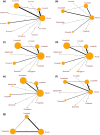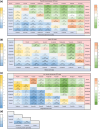Efficacy of GLP-1 Receptor Agonist-Based Therapies on Cardiovascular Events and Cardiometabolic Parameters in Obese Individuals Without Diabetes: A Meta-Analysis of Randomized Controlled Trials
- PMID: 40207414
- PMCID: PMC11982705
- DOI: 10.1111/1753-0407.70082
Efficacy of GLP-1 Receptor Agonist-Based Therapies on Cardiovascular Events and Cardiometabolic Parameters in Obese Individuals Without Diabetes: A Meta-Analysis of Randomized Controlled Trials
Abstract
Background: The cardioprotective effects of glucagon-like peptide-1 receptor agonist (GLP-1RA)-based therapies in nondiabetic individuals with overweight or obesity remain underexplored. This meta-analysis evaluates their impact on cardiovascular events and metabolic parameters in this population.
Methods: A meta-analysis was conducted using PubMed, Embase, Cochrane, and Web of Science databases from inception to June 18, 2024. Eligible studies were randomized controlled trials (RCTs) enrolling nondiabetic adults with overweight or obesity. These studies compared GLP-1RA-based therapies with placebo and reported cardiovascular events and metabolic parameters.
Results: A total of 29 RCTs involving 9 GLP-1RA-based drugs and 37 348 eligible participants were included. Compared to placebo, GLP-1RA-based therapies significantly reduced the risk of total cardiovascular events (relative risk: 0.81, 95% confidence interval [CI]: [0.76, 0.87]), major adverse cardiovascular events (0.80, [0.72, 0.89]), myocardial infarction (0.72, [0.61, 0.85]), and all-cause mortality (0.81, [0.71, 0.93]). No significant differences were observed in cardiovascular death or stroke. Additionally, GLP-1RA-based therapies were associated with significant reductions in some cardiometabolic parameters. Among GLP-1RA-based therapies, orfroglipron demonstrated strong benefits in reducing systolic blood pressure (mean difference: -7.10 mmHg, 95% CI: [-11.00, -2.70]). Tirzepatide induced the greatest reduction in body mass index (-6.50 kg/m2, [-7.90, -5.10]) and hemoglobin A1c concentrations (-0.39%, [-0.52, -0.26]). Retatrutide and semaglutide were most effective in improving lipid profiles and reducing C-reactive protein levels (-1.20 mg/dL, [-1.80, -0.63]), respectively.
Conclusions: In nondiabetic individuals with overweight or obesity, GLP-1RA-based therapies significantly reduce cardiovascular events and improve cardiometabolic parameters. These findings underscore the potential for individualized GLP-1RA-based therapies targeting cardiovascular risk factors.
Keywords: GLP‐1 receptor agonist‐based therapies; GLP‐1RAs; cardiometabolic; cardiovascular disease; meta‐analysis; obesity or overweight.
© 2025 The Author(s). Journal of Diabetes published by Ruijin Hospital, Shanghai JiaoTong University School of Medicine and John Wiley & Sons Australia, Ltd.
Conflict of interest statement
The authors declare no conflicts of interest.
Figures






References
-
- Roth G. A., Nguyen G., Forouzanfar M. H., Mokdad A. H., Naghavi M., and Murray C. J., “Estimates of Global and Regional Premature Cardiovascular Mortality in 2025,” Circulation 132, no. 13 (2015): 1270–1282. - PubMed
-
- Zhao D., Liu J., Wang M., Zhang X., and Zhou M., “Epidemiology of Cardiovascular Disease in China: Current Features and Implications,” Nature Reviews Cardiology 16, no. 4 (2019): 203–212. - PubMed
-
- Ward Z. J., Bleich S. N., Cradock A. L., et al., “Projected U.S. State‐Level Prevalence of Adult Obesity and Severe Obesity,” New England Journal of Medicine 381, no. 25 (2019): 2440–2450. - PubMed
Publication types
MeSH terms
Substances
Grants and funding
- 82088102/National Natural Science Foundation of China
- 82170819/National Natural Science Foundation of China
- 82370810/National Natural Science Foundation of China
- 91857205/National Natural Science Foundation of China
- 92157204/National Natural Science Foundation of China
- Innovative Research Team of High Level Local Universities in Shanghai
- 23JS1400900/Science and Technology Commission of Shanghai Municipality
- 23XD1422400/Science and Technology Commission of Shanghai Municipality
- 23Y11908400/Science and Technology Commission of Shanghai Municipality
- 202340084/Shanghai Municipal Health Commission
- 2021YFA1301103/National Key Research and Development Program of China
- 2022YFC2505201/National Key Research and Development Program of China
- 2022YFC2505202/National Key Research and Development Program of China
- 2023ZD0508402/National Key Research and Development Program of China
- 24ZR1447400/Natural Science Foundation of Shanghai
LinkOut - more resources
Full Text Sources
Medical
Research Materials

